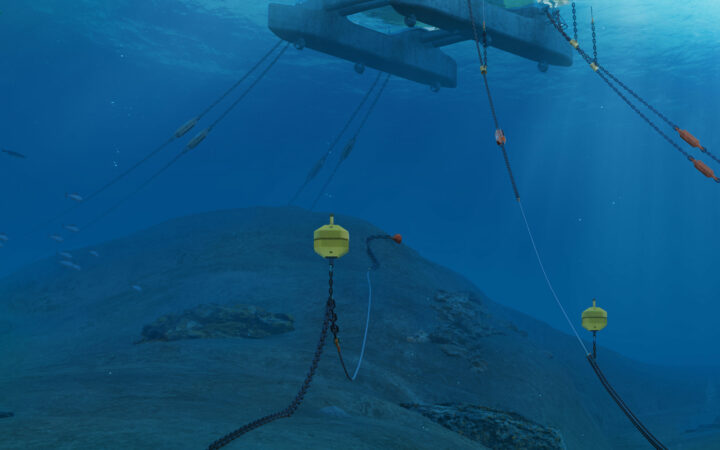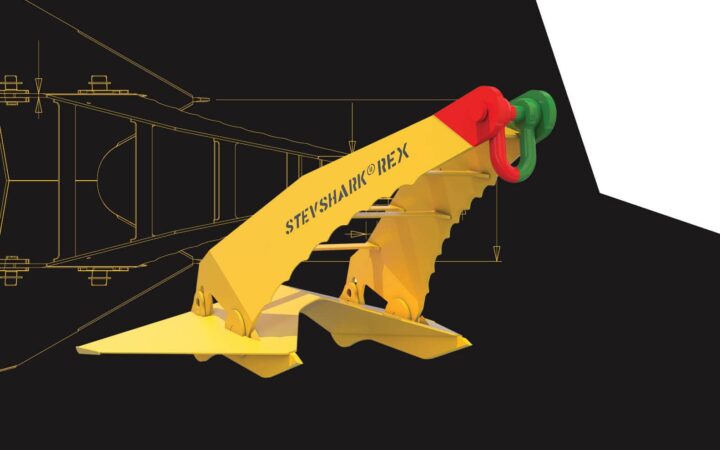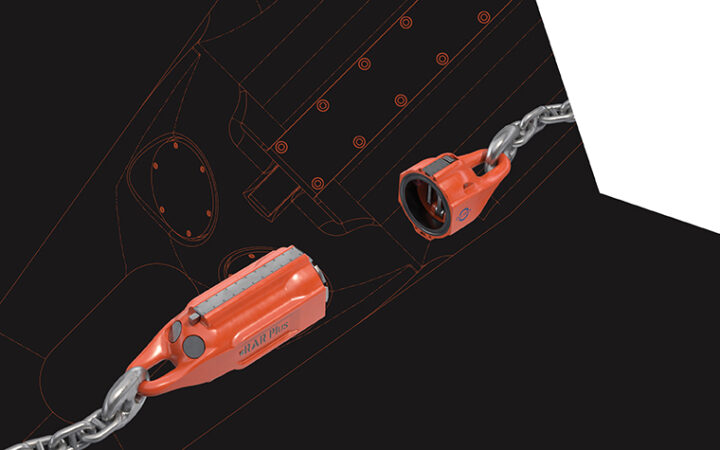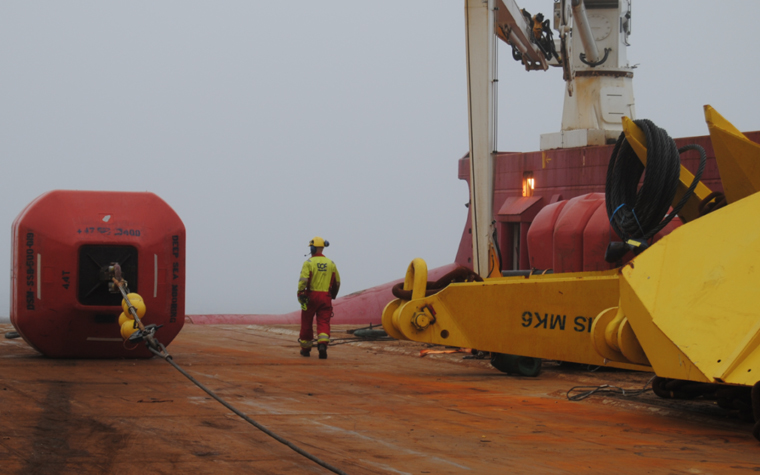Rental of Mooring Equipment
Delmar Systems provides a wide variety of total mooring solution rentals to serve the needs of the Energy Industry. Our solutions are individually engineered and designed to optimize mooring equipment requirements while adhering to local and industry regulations.
We offer mooring rental equipment which may be used to make up a releasable mooring systems, conventional mooring spreads, insert or supplemental mooring line components, synthetic mooring lines, or suction or gravity installed anchor systems. These systems include high holding capacity anchors, large diameter chain, an array of fiber rope and large mooring wires, high capacity spooling units, inspected connections, and a diverse inventory of proprietary products unique to Delmar which provide specialized solutions to complex situations.
Recovery and deployment of these mooring systems is performed by Delmar’s highly experienced professional anchor handling crews and engineering staff.
Releasable Mooring System
Delmar Systems' Releasable Mooring System is perfectly suited for the moored and DP/moored semi-submersible rig fleet and offers maximum efficiency, flexibility, and safety for operators and rig owners.
Developed with the experience of thousands of successful rig moves, our Releasable Mooring System greatly reduces risks and provides a path to regulatory approval for eight-line MODU systems in regions that have historically required more time-consuming and costly mooring spreads.
Conventional system rentals
Most semi-submersible drilling rigs are fitted with wire, chain, or combination wire/chain catenary mooring systems. These mooring systems can employ high-holding power anchors with 3″ or 3 1/4″ anchor chain and mooring wire of at least 3″ in diameter.
These types of systems are typically “self-contained” onboard the drilling rig. The limiting factor for conventional catenary mooring systems is their length, weight, and ability to hold the rig within the desired minimum watch circle in greater water depths.
Insert system rentals
In a situation when a rig’s conventional catenary mooring system is not sufficient for a proposed water depth, the length of the mooring legs can be increased with the addition of extension wires, chain or synthetic mooring lines placed in any or in each mooring leg. This enhancement extends the length of the mooring legs for the rig, thus allowing the rig to operate in greater water depths or extend line length in order to avoid subsea obstructions.
The process of accomplishing this economical upgrade is accomplished using one or two anchor handling vessels (AHVs). In a two AHVs scenario, increased efficiency may be realized as one vessel installs the extension component into the mooring leg while the other vessel deploys the anchor.
The two vessel process begins with one AHV receiving the rig chaser and holding the anchor while the rig deploys its mooring gear to a predetermined length or practical separation point. The second AHV catches the mooring line with a J-lock chaser and brings the mooring chain on deck. The rig mooring line is taken apart at a designated point, the insert component is deployed and connected back to the rig mooring line and the insert vessel releases the mooring system. The anchor is then pulled out to the proposed anchor drop point and lowered to the seabed. This rig tensions the mooring leg to apply the required tension for returning the permanent chaser to the rig. With the exception of inserting additional mooring component, the mooring operation remains the same as conventional catenary mooring.
Recovery of the mooring leg is the reverse of the installation. With this enhanced operation, the time required to set or recover the extended mooring leg is minimized in extreme water depths with multiple extensions. This process may be efficiently accomplished with two anchor handling vessels.
Influences from water depth, weather, and rig operation are similar to the conventional catenary mooring operation. Delmar has a large inventory of certified mooring gear available to extend the water depth of any rig.
During normal operations, the installation or recovery of these moorings is accomplished with either one or two anchor handling vessels (AHVs). Each AHV will work opposing mooring legs of the rig simultaneously while a tug is used for station-keeping assistance. Size and horsepower of the AHVs are key elements which Delmar takes into consideration when designing these types of mooring operations.
Preset system rentals
If a situation requires upgrading or specialization of a rig’s mooring system for a desired water depth or as special location conditions dictate, it may be cost-effective to pre-install an enhanced mooring system for the rig to use at that drilling location.
Anchors, chain, and wire or synthetic mooring gear can be installed on the location prior to rig arrival and off the critical path time of rig operations. Some of the rig’s standard mooring components may need to be removed before arriving at the preset location.
Once the rig arrives at the drilling location, its remaining mooring equipment is connected to the pre-installed system with one or two anchor handling vessels (AHVs).
Delmar typically designs preset mooring systems such that a single AHV can install each leg of the preset mooring system. The mooring leg components are transported to location and deployed at the designated coordinates. Surface buoys or float ropes at the seafloor are commonly attached to each pre-deployed leg for quick recovery for the rig connection phase of the project. Once the rig arrives on location, the AHVs connect the rig to the pre-installed mooring lines.
The disconnection of the rig is accomplished in a similar manner with either the rig’s mooring components being re-installed or the rig being moved to another preset mooring system.
A preset system should allow the rig connection to be completed in less time than is required to conventionally deploy the rig’s self-contained mooring system. However, this is influenced by whether the rig’s self-contained mooring components have to be removed or reinstalled on the rig and various other factors that may affect the mooring procedure.
Water depth, length of well drilling schedule, as well as vessel and rig day rates, all play a significant role in determining the economics of a preset scenario. These factors should be studied to determine the most economical means of mooring the rig.
The preset system may be significantly more economically feasible when it is necessary to supplement the rig’s moorings to a significant degree, beyond the simple mooring extension, or if seabed features or pipeline interference make conventional anchor deployment impractical.
Polyester
Delmar maintains the world’s largest inventory of polyester mooring rope for MODU floating mooring use, complete with connection hardware. Delmar can design and install a polyester mooring system for use in the most challenging mooring conditions. Delmar has also been able to introduce synthetic moorings as a means of problem solving in what is considered more shallow water and conventional mooring projects. Crowded seafloor conditions, pipeline avoidance, and mooring pattern interference with adjacent rigs present challenges where synthetics have played a major role. These applications have been used to reduce the risk of steel mooring components suspended over pipelines or subsea equipment and also reduce the scope of mooring lines in order to facilitate close proximity mooring to other structures.
Synthetic mooring components can be used repeatedly with minimal wear and increased service life beyond what traditional steel wire rope systems can offer. Some synthetic mooring line configurations also provide for increased stationkeeping and mooring reliability than all steel mooring component systems can offer.
Suction Anchor
Suction anchors may be used in moderate to ultra-deepwater applications for systems typically requiring taut or semi-taut preset mooring systems. We have a fleet of suction anchors than are offered on a rental basis along with the ability to provide anchors of specific designs to customer projects. Our MODU floating mooring suction anchors are designed to simplify both the installation and recovery processes. Delmar has installed and retrieved more suction anchors than any other offshore contractor.
This system uses a suction caisson as the anchor. The caisson is cylindrical in shape with the bottom end open. Embedment of the anchor is accomplished by using an ROV to pump water out of the top of the caisson until it is fully penetrated into the seabed. The process is simply reversed to recover the anchor.
A rig- and location-specific mooring analysis can determine the desired configuration for each system.
The suction anchor system is installed using Delmar’s proprietary single vessel/single line installation method before the rig arrives, which uses one vessel with ROV capability. The anchor is overboarded, lowered, and pumped into the seabed. The preset mooring line may be attached subsequently or at any later date via the Delmar subsea Connector. These mooring lines can be abandoned by means of floating marker pennants at the seafloor, submersible buoyancy modules or surface marker buoys.
Once the rig is on location, it is connected to the mooring legs by one or two anchor handling vessels (AHVs) in a short amount of time.
The recovery of the system is a simple process with the suction anchor being pumped out of the seabed and recovered over the stern of the vessel. Delmar’s methodology provides that no extraordinary AHVs specialized equipment is required for the handling of the suction anchors, there is no need for a-frames, gantrys or deck cranes.
Delmar’s suction anchor system method centers around the use of the original and patented Delmar Subsea Connector (DSC), which allows the anchor to be deployed with a single line and the mooring line to be connected or disconnected at any time by an ROV.
This capability adds significantly to the flexibility of the system and reduces the cost of installation and recovery.
The advantage of the suction anchor mooring system is the anchor’s ability to hold at higher uplift angles, thereby reducing the circumference of the mooring pattern and watch circle maintained by the rig. The suction anchor system provides excellent performance in ultra-deepwater and allows a rig to significantly extend its water depth capability.
Another significant advantage of the suction anchor is the ability to target an exact location, its soil-holding properties, and alignment to the rig, allowing confidence in the anchor’s ultimate hold capacity. Submersible syntactic buoys, or use of synthetic mooring component in the mooring system, reduces the weight of the mooring leg on the rig and increases the station keeping performance.
The suction anchor system is a safe and cost-effective alternative to dynamic positioning for ultra-deepwater drilling and development. The use of the Delmar Subsea Connector makes the system ideal for permanent installations where a single AHV can install and maintain the entire mooring system at a fraction of the cost required for conventional permanent mooring.









